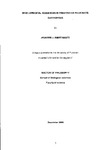DEVELOPMENTAL SEQUENCES IN FRESHWATER PULMONATE GASTROPODS
| dc.contributor.author | SMIRTHWAITE, JENNIFER J. | |
| dc.contributor.other | School of Biological and Marine Sciences | en_US |
| dc.date.accessioned | 2013-10-29T11:50:07Z | |
| dc.date.available | 2013-10-29T11:50:07Z | |
| dc.date.issued | 2008 | |
| dc.identifier | NOT AVAILABLE | en_US |
| dc.identifier.uri | http://hdl.handle.net/10026.1/2438 | |
| dc.description.abstract |
The main aims of this thesis were to develop an integrative approach (i.e. one that included physiological as well as traditional morphological events) that allowed the construction of "timelines" of event sequences during development for pulmonate gastropods and to investigate how these sequences varied between (heterochrony) and within (heterokairy) species. Detailed descriptions of development in twelve species from three families (Lymaeidae, Planorbidae and Physidae) highlighted several heterochronies that were confirmed by a phylogenetically explicit analysis (PARSIMOV). These heterochronies involved physiological events (i.e. the first heart beat, appearance of the eye, body flexing, mantle muscle activity, attachment to egg capsule and crawling) and were associated with basal and terminal branches within the phylogeny. The same sequence-based approach also demonstrated altered relative times of onset of developmental events (i.e. heterokairy) and durations of key developmental stages in three pulmonate species (Physella acuta, Radix balthica and R. auricularia) exposed to predator cues. Species varied in their degree of response and in the events showing alterations but there were no obvious overall effects on development. A further study of the developmental sequences in three pulmonate species with a simple conical shell form revealed additional evidence for heterochrony, including the early occurrence of hatching in a possible ancestral lineage (the family Acroloxidae). Together these findings suggest that sequence heterochrony may have played an important role in the evolution of freshwater pulmonate gastropods and that this group of invertebrate could offer the opportunity to address the potential link between heterochrony (the pattern) and heterokairy (the – potential – process). | en_US |
| dc.language.iso | en | en_US |
| dc.publisher | University of Plymouth | en_US |
| dc.title | DEVELOPMENTAL SEQUENCES IN FRESHWATER PULMONATE GASTROPODS | en_US |
| dc.type | Thesis | |
| plymouth.version | Full version | en_US |
| dc.identifier.doi | http://dx.doi.org/10.24382/3607 |
Files in this item
This item appears in the following Collection(s)
-
01 Research Theses Main Collection
Research Theses Main


